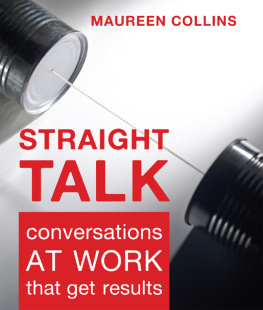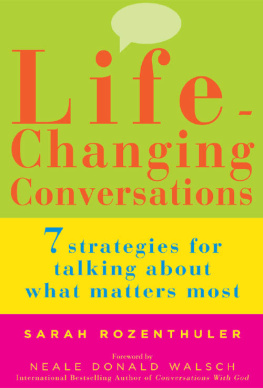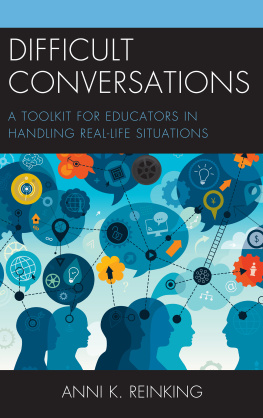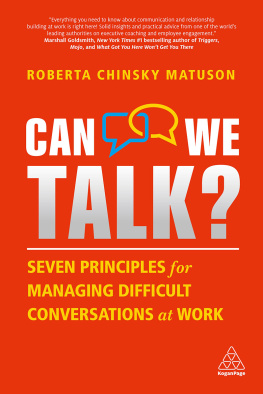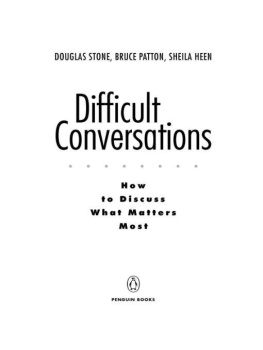STRAIGHT
TALK
conversations
AT WORK
that get results
MAUREEN COLLINS
To my clients
For the energy and humour you bring to my workshops and for all the conversations you have shared with me
For the passion youve shown in applying the straight-talk skills in your own lives
For all youve taught me: I couldnt have written this book without your help
CONTENTS
Choose words that direct your conversations to the real issues
Plan conversations before you start so that they dont turn into arguments
Present facts first, not opinions, and create a safe platform for dialogue
When you know how to defuse emotions, conversations dont get out of control
You only get the whole picture when others speak up with their ideas and opinions
You must know how to hold people to account for the consequences of their behaviour
It is important to listen as carefully as you speak so that you get all sides of the story
Commitment to action is essential in ensuring that problems are properly solved
ACKNOWLEDGEMENTS
My thanks go to all the people with whom I have ever had a difficult conversation you know who you are! At the time I had no idea how much I was learning or how it would eventually come together as Straight Talk. The learning wasnt easy, but thank you for the opportunities.
Id like to acknowledge Kerry Patterson and his team, Joseph Grenny, Ron McMillan and Al Switzler, the authors of Crucial Conversations (New York: McGraw Hill, 2000), one of the first books on difficult conversations that caught my attention and helped me put my thoughts in order.
My thanks also to Susan Scott, author of Fierce Conversations (New York: Berkley Publishing Group, 2002) for her down-to-earth insights and approach.
I have learnt so much from participants in my workshops. Thank you for the conversations you have shared and the insights you have given me.
Finally, to Ian Mann of Gateways Business Consultants: Ian, thank you for your friendship, guidance and inspiration in more ways than you realise.
INTRODUCTION
Ive spent much of my corporate life in heavy industry, working with people who have solid degrees in science or engineering and who hold down serious jobs running mining operations or managing chemical plants. These are hazardous working environments. Production output and safety are the priorities and discipline is tight. It is a tough world, and you have to be tough to work in it.
I, with my psychology degree, was in human resources. The line managers around me mostly referred to human resource management as a soft skill and werent shy in letting me know that they thought mine was definitely a second-class occupation. While they dealt with pressure tests, production records and productivity, my job was to help people hold more effective conversations!
In my consulting practice, I have worked in many other environments: banking, financial services, pharmaceuticals, hospitality and telecoms, to name but a few. While in many ways each is a very different environment, they all share one characteristic: even the toughest people run for cover when tough conversations are required.
Few of us enjoy difficult conversations. Very few of us have the skills to handle them effectively. Left with only two options biting our tongues or blowing up we are unable to deal properly with many of the interpersonal problems we encounter in the workplace. As a consequence, leadership and management styles are ineffective, teams are dysfunctional, client relationships are scarcely worthy of the name, and working relationships are strained and unsatisfying.
Tough conversations are nothing new. A common one in the workplace is with an employee who says, How am I doing? In your opinion as a manager, the person is not performing nearly as well as you would like, and you know that you should tell the employee so. But youre scared of conflict and afraid the conversation will end up in an argument. So you delay the conversation for as long as possible, hoping that the problem will somehow solve itself and disappear.
That doesnt happen, of course, and one day, when you are feeling particularly frustrated, your feelings get the better of you and you burst out, blaming and accusing. Not unexpectedly, your outburst doesnt improve the persons performance and doesnt do anything to improve your working relationship, either.
We all know that it is the quality of the conversations between managers and their people that makes the difference to personal development, motivation and working relationships. Yet managers avoid many of these conversations or handle them poorly. They replace honesty with avoidance and politeness. They fail to hold people accountable for their performance and, when all else fails, they resort to discipline.
This book focuses on the conversations managers and leaders encounter on a day-to-day basis. Most of these concentrate on managing performance: dealing with employees who perform poorly, behave badly or who have negative attitudes. It also deals with some conversations between colleagues, and up the line with other senior people. The conversations we have in our social and family lives are not covered specifically in this book, but the guidelines and approaches explained here apply just as effectively to other areas of our lives.
Straight Talk provides a set of skills that helps you deal with any difficult conversation. Firstly, it helps you to find a solution or a change in behaviour that resolves the problem. Secondly, it does so in a way that helps you build better relationships with the people youre talking to.
If you use straight talk, you will soon be able to talk to almost anyone about almost anything. I say almost, because this is no magic potion. The first principle of straight talk is that you always choose your battles, and there will be some conversations with certain people that you will forever quite rightly choose to sidestep. Nevertheless, the more skilled you become at using the steps explained in the book, the more you will find that there are very few issues that you cannot put on the table safely and discuss constructively.
You will also find that a little straight talk goes a long way. Each of the eight chapters covers a particular step in the process of holding a conversation. Handling any one of these steps effectively can make a noticeable difference to the tone of a conversation and to the outcome you achieve. The book is designed to be read from beginning to end. However, you can also dip into it at any point if you want to focus on a particular problem that you are aware of in your own conversations.
In each chapter youll find dialogue for several conversations that take place between a manager and the people with whom he works. His conversations and relationships with these people form a thread through the book and provide practical models for many difficult conversations. All of these examples are based on real-life situations that I have discussed often in workshops with clients. I owe them many thanks for the conversations they have shared with me and the enthusiasm with which they have applied straight talk in their own lives.
I hope you enjoy reading the book and that you will be able to relate to the examples and conversations detailed in it. Most of all, I hope you will take the material and apply it to your own conversations so that you can experience for yourself the impact straight talk can have on your relationships with others.

